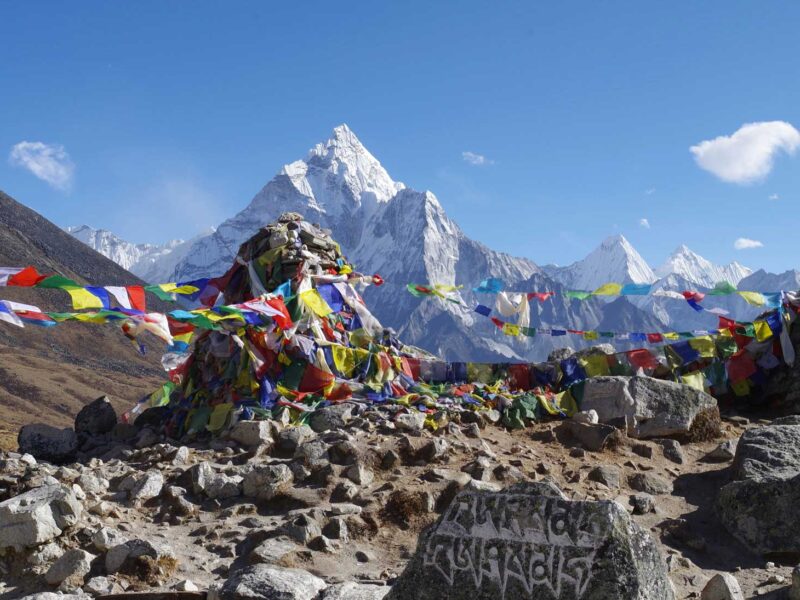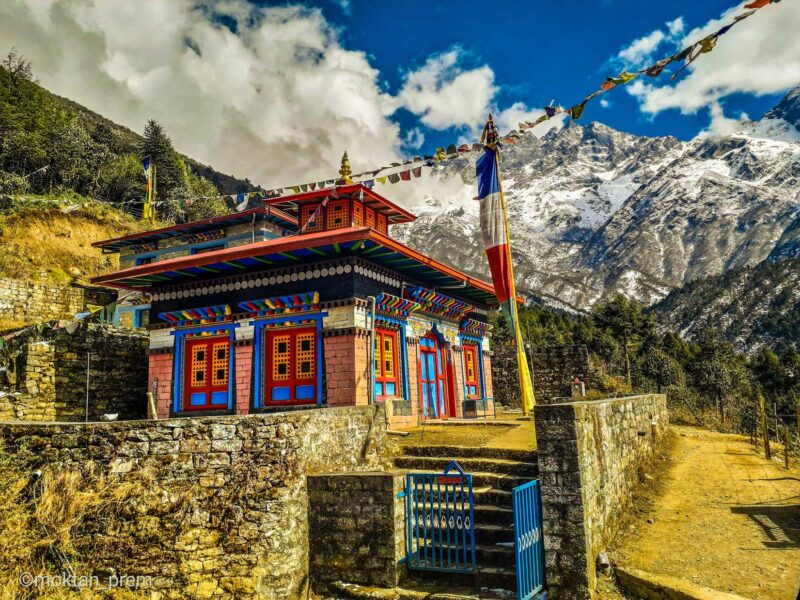What to expect on the trail from Thukla to Lukla



Starting the trek from Thukla to Lukla on the Everest Base Camp (EBC) trek is an enriching experience, combining physical hardship with emotional connection. This leg passes through the hardscrabble landscapes of the Khumbu region, providing trekkers not just stunning views but also a rich sense of connection to the area’s mountaineering culture.
The Trail from Thukla to Lukla
The Thukla to Lukla trail is a 20-kilometer drop, with the trek crossing mixed terrain, ranging from alpine meadows to dense forests. The initial portion of the drop from Thukla is steep, with the trail dropping down along boulder-strewn trails and open forests. As one nears the floor of the valley, the ground flattens out, with the trail crossing dense forests and small Sherpa villages.
One of the most pathetic aspects of this division is the Thukla Pass, which is located just above Thukla. There are thousands of memorials here to mountaineers who have perished on Mount Everest. One such memorial is a memorial to Scott Fischer, an American mountaineer who died in the 1996 Everest disaster. These memorials serve as a grim reminder of the risks to which climbers are subject and the price paid in trying to reach the summit of the world’s highest peak.
As the trek progresses, the trekkers hike through the village of Dingboche, which is a typical acclimatization point. The village is characterized by a change in scenery, as the terraced fields give way to rocky hillsides, and the massive peaks of the Himalayas become increasingly vast. The village gives one an insight into Sherpa culture, with stone buildings and billowing prayer flags as far as the eye can see.
Descending further, the trek leads a person to the village of Pheriche at an elevation of approximately 4,371 meters. It is a favorite for trekkers to stop and rest, so one can acclimatize before the final leg. The mountains, including the stunning Ama Dablam, are a captivating background.
The last leg to Lukla is a gentle descent, passing the village Phakding. The trek is well worn, with several teahouses providing refreshments and respite. As one enters Lukla, the terrain becomes greener, with thick forests and the din of running streams on the way.
Lukla itself is a bustling town, being a gateway to the Everest region. One of the town’s landmarks, whose brief runway and naturalistic backdrop demands everybody’s focus, is The Tenzing-Hillary Airport. Lukla flights return the trekkers to Kathmandu, thus concluding their Himalayan experience.
Cultural Insights
Through the Thukla to Lukla route, travelers are immersed in Sherpa culture. The prevalence of monasteries, prayer wheels, and chortens signals the strong Buddhist tradition of the region. Hospitality and stoicism of the Sherpa locals are the causes of a large proportion of the trekking trade, leading and helping adventurers from around the world.
Development of Trekking Infrastructure
The path now is unrecognizable from 20 years ago—more lodges, bridges, and availability of electricity and Wi-Fi.
Teahouses have evolved from basic huts into multi-room lodges with plug-in points and varied menus.
Villages like Namche have embraced modernity while retaining their Sherpa heritage.
Historical Significance of the Route
The hike to Everest Base Camp and back up from Lukla is the very path followed by heroes Tenzing Norgay and Sir Edmund Hillary.
Old monasteries and prayer stones date from hundreds of years ago.
Many of the trails in existence used to be original yak trade trails between Nepal and Tibet.
Booking and Accommodation Logistics on the Return Trip
Do I pre-book or wing it? Pros and cons for both.
Best teahouses by location (e.g., Rivendunde Lodge in Debuche).
Photographic Opportunities on the Return Trek
Great spots: Thukla Memorial Ridge, Pheriche Valley, Ama Dablam viewpoints.
Wildlife shots: If lucky, Himalayan tahr or snow pigeons.
Night photography: Less light pollution leads to great Milky Way photographs from Tengboche and Pangboche.
Sherpa Chats and Local Knowledge
Some trekkers have more meaningful interactions with guides/porters on the return journey.
Guides share personal stories about mountain life, Everest summit tales, and local myths.
Learning some simple Nepali/Sherpa words adds to cultural exchange.
Trail Care and Maintenance Projects
Who will ensure the trail remains clean? (Hint: local village councils, NGOs, and trekkers’ permits)
Erosion problem, especially during the monsoon season.
How and why climate change is impacting glaciers, bridges, and trails.
Trekkers’ Culture and Friendships
Bonds on the trail are forged here—tend to be stronger on descent.
People begin to open up more after achieving EBC.
Telling tales over steaming hot tea is a daily ceremony in teahouses.
Coming Back to Life After EBC
Trekkers experience a kind of reverse culture shock in coming back to “normal” life.
People say they experience more gratitude, patience, and motivation.
This part of the trek helps “recalibrate” before coming back home.
Helicopter Evacuations and Safety Precautions
Why some trekkers opt for heli rides from Pheriche or Namche.
Emergency procedures should altitude sickness hit even on the way down.
Cost, insurance, and what to do on evacuation.
Symbols and Signs You’ll See Along the Trail
Prayer flags strung across bridges and hills.
Mani stones carved with mantras like “Om Mani Padme Hum.”
Stupas (chortens) guarding trail entries and exits.
Notable Villages and Stops Along the Way
Every village has character:
Thukla: Starting point, significant mostly for the Thukla Pass Memorial site above the village.
Pheriche: Flat, windy valley with a medical aid post run by the Himalayan Rescue Association.
Pangboche: Oldest monastery in the Khumbu, stunning views of Ama Dablam.
Tengboche: Spiritual center with the famous Tengboche Monastery; scenic rest stop as well.
Namche Bazaar: Largest village in the Khumbu with coffee shops, lodges, bakeries, and stores.
Phakding: Scenic forest environment, relaxed atmosphere before the final leg.
Lukla: The final stop with the Tenzing-Hillary Airport and festive ambiance.
Thukla Pass Memorial Site
One of the most emotional parts of the trail. A ridge above Thukla is blanketed in stone memorials and inscribed plaques to climbers who lost their lives on Everest—including Scott Fischer and Rob Hall of the 1996 tragedy.
The site is sobering, wind-swept, and humbling. Several trekkers stop by for reflection or to leave prayer flags. It is a sober reminder of the risks of high-altitude adventure.
Changing Landscapes and Ecology
As you descend, you literally walk through different ecosystems:
Above Pheriche: Alpine tundra with minimal vegetation.
Near Pangboche: Shrubs, juniper, and dwarf rhododendrons.
Tengboche & Below: Lush forests with pine, oak, and rhododendron (especially in spring).
Wildlife: Look out for Himalayan tahr, musk deer, and colorful birds like the Himalayan monal (Nepal’s national bird).
Timeless Mountain Vistas on the Descent Path
Even though Everest gradually disappears from view, other magnificent peaks provide company:
Ama Dablam is a reassuring presence, with spectacular views especially from Pangboche and Tengboche.
Thamserku, Kangtega, Nuptse, and Lhotse are seen in many a bend in the path.
Pheriche Valley offers expansive, open vistas that are great for photography.
Clear spring and autumn weather creates stunning sunrises and sunsets.
Food and Teahouse Experience
Downhill, food improves a little—more vegetables, fresher food, even coffee machines in Namche.
Typical meals: Dal bhat, noodles, pasta, pancakes, garlic soup (for altitude).
Namche and Lukla offer bakeries, pizza, and good espresso!
Teahouses become more luxurious, with warmer blankets, solar showers, and even Wi-Fi in most teahouses.
Cultural and Spiritual Encounters
The trail winds through the Buddhist stronghold of the Sherpa people, with spirituality seeping in:
Tengboche Monastery – Attend morning prayers if time allows.
Main walls, prayer flags, chortens – Polite to pass left of them.
Pious locals offer blessings or light butter lamps for safe passage.
Chants of “Om Mani Padme Hum” are heard echoing through the hills.
Physical & Emotional State on the Return
Coming down from EBC can be bittersweet:
Physically: Glad to be at lower altitude, but legs bear the impact of the descent.
Emotionally: Some trekkers cry or are contemplative after such a life-altering experience.
Mentally: Easier to think, dream, and reminisce about the trek with the increasing oxygen levels.
You also bond more with fellow trekkers—laughing, reflecting, event planning the next trek.